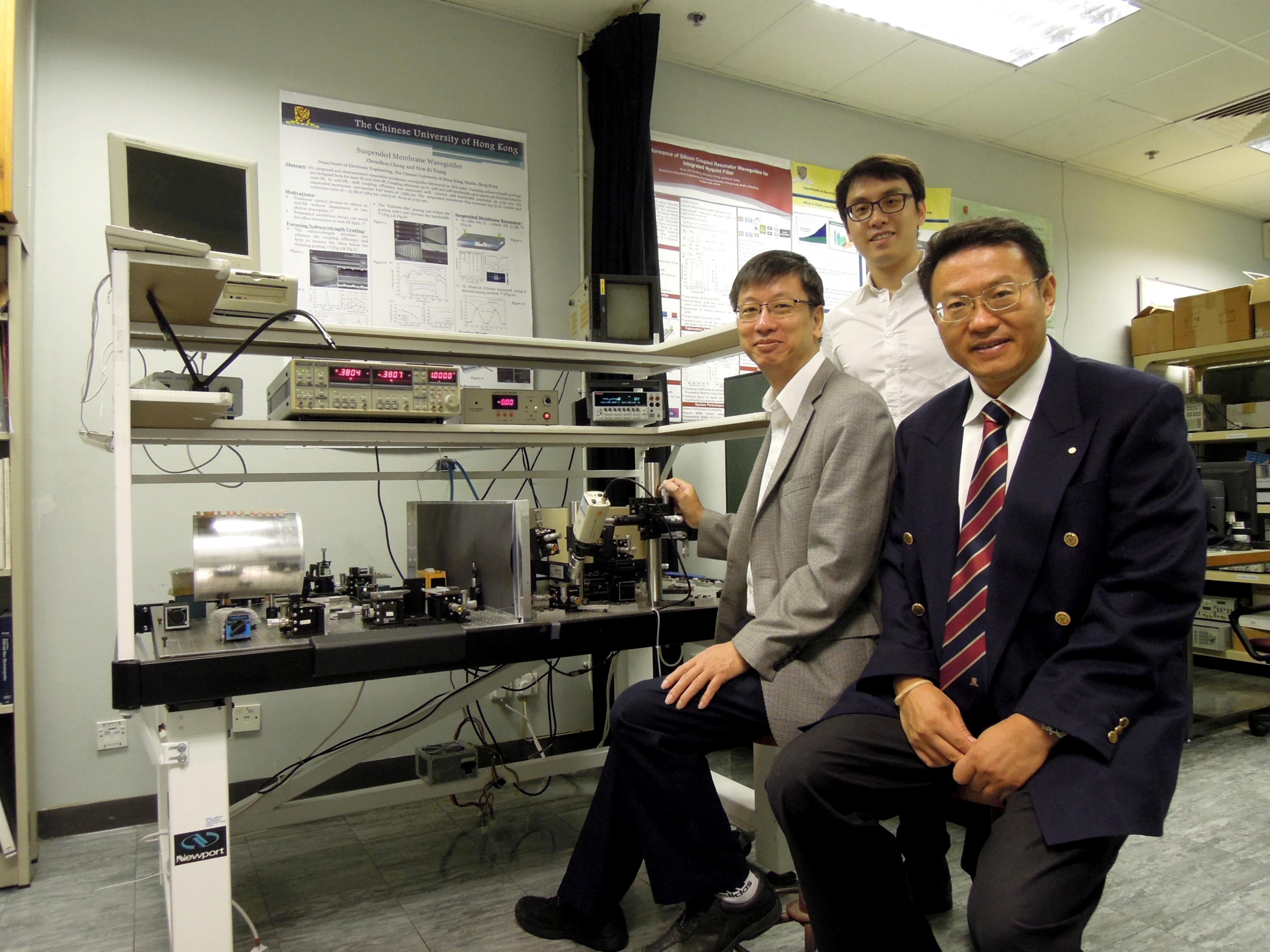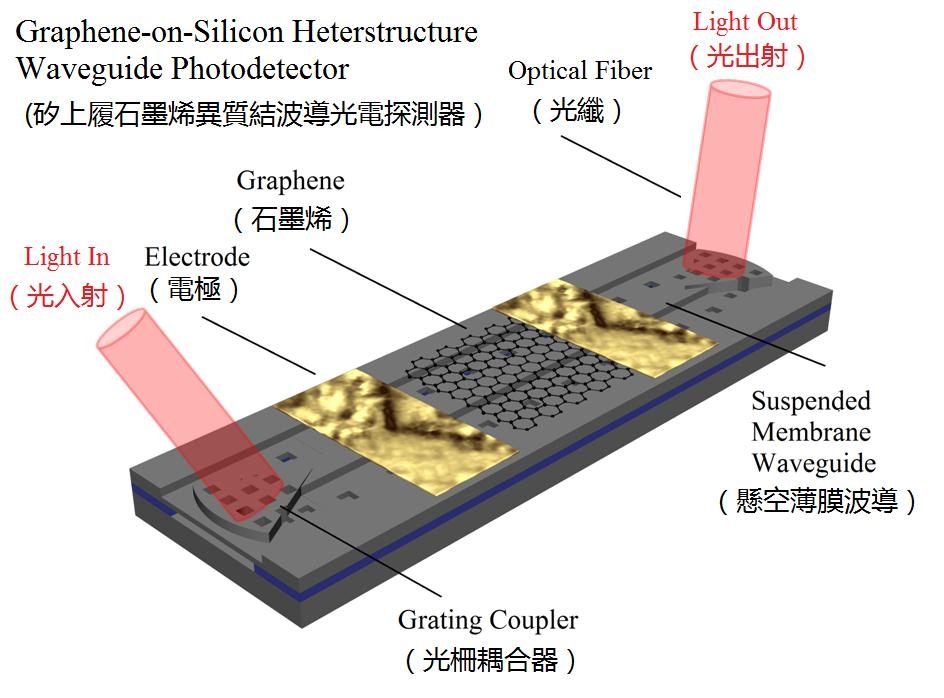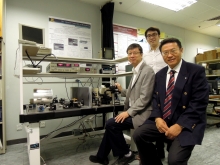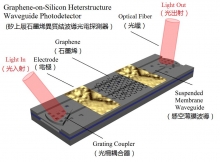CUHK
News Centre
CUHK’s Groundbreaking Development in Mid-IR Photo Detection
Prof. Hon Ki TSANG and Prof. Jian-Bin XU and their research team of the Department of Electronic Engineering at The Chinese University of Hong Kong (CUHK) have successfully constructed a new device for detecting light in the mid-infrared (mid-IR) spectral region. This groundbreaking work is expected to enable a new generation of high efficiency, low cost, and highly integrated mid-IR detectors which proceeds to the applications of mid-IR spectroscopy in environmental and biomedical engineering. The chemical spectroscopy can detect trace concentrations (parts per billion) of gases for enormous applications, such as air pollution monitoring and analysis of human breath for disease markers. The research results have been published today (16 September) in the latest issue of Nature Photonics. Meanwhile, the news column of Nature – Nature News and Nature Photonics published their technical commentaries by the top experts. For details, please see
http://www.nature.com/nature/journal/v501/n7467/full/501284b.html
http://www.nature.com/news/graphene-makes-light-work-of-optical-signals-1.13744
http://www.nature.com/nphoton/journal/vaop/ncurrent/full/nphoton.2013.257.html
http://www.photonicsonline.com/doc/graphene-on-chip-closing-the-gap-with-germanium-0001
Led by Prof. TSANG and Prof. XU, the CUHK research team placed the graphene, which is a single layer of carbon atoms that could be obtained by ‘scotch tape’ mechanical exfoliation from graphite, on the top of a silicon suspended membrane optical waveguide, to make a heterostructure photodetector. The device could operate over a wide range of wavelengths at room temperature. This groundbreaking work is expected to enable a new generation of high efficiency, low cost, and highly integrated mid-IR detectors. The research team proves that the heterostructure formed by placing monolayer graphene on silicon optical waveguide can detect mid-IR light with high sensitivity. Material preparation, device design, fabrication and measurement were all performed by members in the Department of Electronic Engineering of CUHK.
Prof. Jian-Bin XU said, ‘Our research team proposed and developed a novel mid-IR focusing grating coupled suspended membrane waveguide on conventional silicon-on-insulator wafers. By placing the graphene layer on the top of the waveguide, it was possible to absorb over 90% of the light in the photodetector. The researchers discovered two distinct regimes of operation of the photodetector that produced different polarities of photocurrent in near-IR and mid-IR wavelength ranges. These studies advance the development of mid-IR light detection technology and proceed to the applications of mid-IR spectroscopy in environmental and biomedical engineering.’
The research team constructed a new device for detecting light in the mid-infrared (mid-IR) spectral region. In the mid-IR (wavelengths from 2 µm to 20 µm), gas molecules typically have strong resonant absorption peaks, and thus the chemical spectroscopy can detect trace concentrations (parts per billion) of gases for enormous applications, such as air pollution monitoring, gas ‘finger-print’ sensing, and analysis of human breath for disease markers. Currently, commercially available mid-IR detectors employ costly low bandgap semiconductors and compound of toxic mercury, and can operate only at low-temperatures.
This is the second article published by Hong Kong research teams in Nature Photonics. In the same issue, there appears independently two relevant reports by research groups from MIT and Vienna University of Technology, Austria.
Graphene, a two-dimensional material, has zero bandgap, so it has an ultra wide spectral bandwidth covers from visible light to terahertz frequency. By integrating the graphene on silicon optical chip, the strong interaction can dramatically enhance the optical absorption, and thereby improve the responsivity of photo detector.
Prof. Hon Ki TSANG is a well established expert in silicon photonics, and he has published over 280 papers in journals and conference proceedings. He is currently the Chairman of the Department of Electronic Engineering, CUHK.
Prof. Jian-Bin XU is a respected expert in nanotechnology and electronic materials. He has published c.a. 300 technical papers, and taken part in a myriad of professional activities and has served as symposium chair at several international conferences. He is Fellow of Hong Kong Institute of Engineers, Senior Member of IEEE, the Secretary and Council Member of the Hong Kong Materials Research Society. Prof. XU is currently Director of Materials Science and Technology Research Centre, CUHK.
Prof. Hon Ki TSANG, Chairman; Prof. Jian-Bin XU, Professor (front row from left) and Dr. Zhenzhou CHENG, Postdoctoral Research Fellow (back row), Department of Electronic Engineering, CUHK. Remarks: Another major team member is Dr. Xiaomu WANG.





